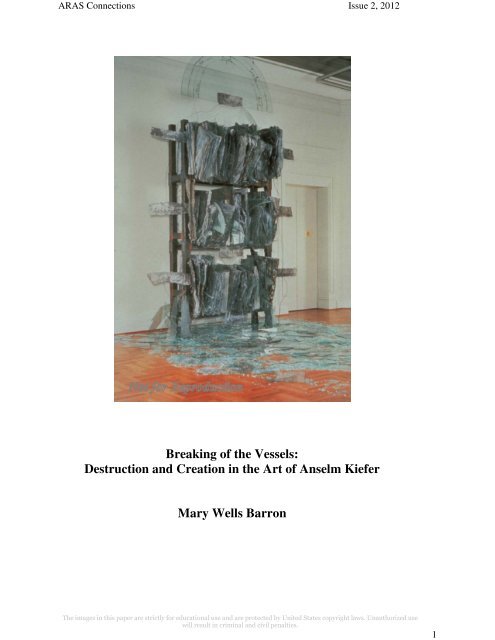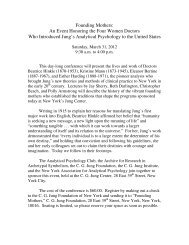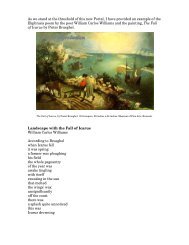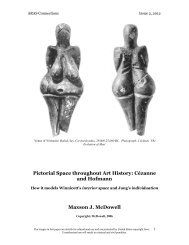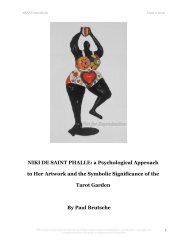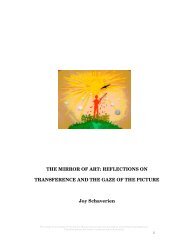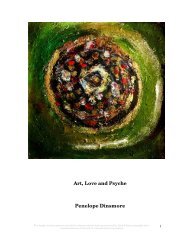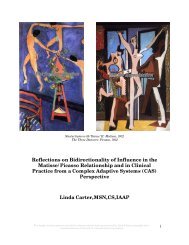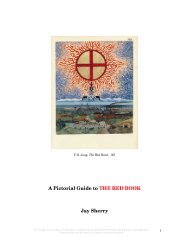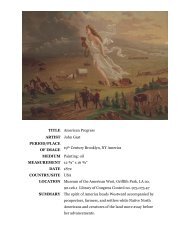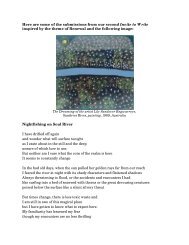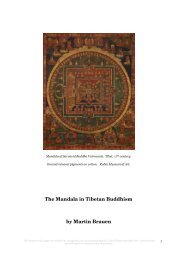Breaking of the Vessels: Destruction and Creation in the Art ... - ARAS
Breaking of the Vessels: Destruction and Creation in the Art ... - ARAS
Breaking of the Vessels: Destruction and Creation in the Art ... - ARAS
You also want an ePaper? Increase the reach of your titles
YUMPU automatically turns print PDFs into web optimized ePapers that Google loves.
<strong>ARAS</strong> Connections Issue 2, 2012<br />
<strong>Break<strong>in</strong>g</strong> <strong>of</strong> <strong>the</strong> <strong>Vessels</strong>:<br />
<strong>Destruction</strong> <strong>and</strong> <strong>Creation</strong> <strong>in</strong> <strong>the</strong> <strong>Art</strong> <strong>of</strong> Anselm Kiefer<br />
Mary Wells Barron<br />
The images <strong>in</strong> this paper are strictly for educational use <strong>and</strong> are protected by United States copyright laws. Unauthorized use<br />
will result <strong>in</strong> crim<strong>in</strong>al <strong>and</strong> civil penalties.<br />
1
<strong>ARAS</strong> Connections Issue 2, 2012<br />
When will you learn, myself, to be<br />
A dy<strong>in</strong>g leaf on a liv<strong>in</strong>g tree?<br />
(Edna St. V<strong>in</strong>cent Millay)<br />
Beh<strong>in</strong>d all <strong>of</strong> Anselm Kiefer’s art sounds <strong>the</strong> leitmotiv <strong>of</strong> destruction <strong>and</strong><br />
creation, both personal <strong>and</strong> collective. My first experience <strong>of</strong> his art was<br />
physical. I walked <strong>in</strong>to <strong>the</strong> largest room <strong>of</strong> <strong>the</strong> St. Louis <strong>Art</strong> Museum shortly<br />
Figure 2 <strong>Break<strong>in</strong>g</strong> <strong>of</strong> <strong>the</strong> <strong>Vessels</strong><br />
(detail)<br />
after my return from almost six<br />
years <strong>in</strong> Zurich. I was seek<strong>in</strong>g<br />
familiar <strong>and</strong> beloved images to help<br />
conta<strong>in</strong> my re-entry anxiety. What I<br />
found was anyth<strong>in</strong>g but familiar. I<br />
encountered this monumental<br />
sculpture that filled <strong>the</strong> wall<br />
between <strong>the</strong> two west doorways,<br />
rose almost to <strong>the</strong> ceil<strong>in</strong>g, was made<br />
<strong>of</strong> metal, <strong>and</strong> seemed to pour out<br />
shattered glass that lay strewn on<br />
<strong>the</strong> floor <strong>in</strong> front <strong>of</strong> me.<br />
I was stopped <strong>in</strong> my tracks <strong>in</strong><br />
much <strong>the</strong> same way one might be who suddenly came upon a beautiful <strong>and</strong><br />
dangerous animal. Frozen to <strong>the</strong> spot, stunned by what had seized me, I had no<br />
idea what stood before me. But my body said what my soul seemed to know, for<br />
a s<strong>in</strong>gle tear ran down my cheek. It came from my right eye, <strong>the</strong> eye <strong>in</strong> which I<br />
have been bl<strong>in</strong>d s<strong>in</strong>ce birth. Then <strong>the</strong>re was only silence. By some fate, I was<br />
totally alone for <strong>the</strong> next twenty m<strong>in</strong>utes. No visitors, no guards walked past. As<br />
The images <strong>in</strong> this paper are strictly for educational use <strong>and</strong> are protected by United States copyright laws. Unauthorized use<br />
will result <strong>in</strong> crim<strong>in</strong>al <strong>and</strong> civil penalties.<br />
2
<strong>ARAS</strong> Connections Issue 2, 2012<br />
I began to emerge from my encounter<br />
with this “terrible beauty,” it felt as if I<br />
might spend a good part <strong>of</strong> my life<br />
explor<strong>in</strong>g its mystery. “…The symbols<br />
<strong>of</strong> <strong>the</strong> Self,” Jung wrote, “arise <strong>in</strong> <strong>the</strong><br />
depths <strong>of</strong> <strong>the</strong> body <strong>and</strong> <strong>the</strong>y express its<br />
materiality as much as <strong>the</strong> structure <strong>of</strong><br />
<strong>the</strong> perceiv<strong>in</strong>g consciousness. The<br />
symbol is thus a liv<strong>in</strong>g body, corpus et<br />
anima” (CW91, par, 291).<br />
Some months later I came upon<br />
<strong>the</strong> words <strong>of</strong> an art critic who spoke <strong>of</strong><br />
see<strong>in</strong>g a woman acqua<strong>in</strong>tance, on<br />
catch<strong>in</strong>g her first glimpse <strong>of</strong> Kiefer’s work, almost fall down. He wrote:<br />
What’s unclear is why so many <strong>of</strong> us experience Kiefer’s works—even <strong>in</strong><br />
<strong>the</strong> first split second <strong>of</strong> a first encounter…as so much more than<br />
gratify<strong>in</strong>g aes<strong>the</strong>tic presences. His big pa<strong>in</strong>t<strong>in</strong>gs <strong>in</strong>still a feel<strong>in</strong>g <strong>of</strong><br />
conviction border<strong>in</strong>g on religious faith, an <strong>in</strong>tuition <strong>of</strong> knowledge which<br />
proves remarkably <strong>in</strong>articulate when you try to debrief people about it.<br />
(Schjeldahl, March 1988, p. 119)<br />
We recognize <strong>in</strong> <strong>the</strong>se words a meet<strong>in</strong>g with <strong>the</strong> num<strong>in</strong>ous, that which is<br />
beyond all description. Silence is our response to <strong>the</strong> presence <strong>of</strong> <strong>the</strong> div<strong>in</strong>e.<br />
Silence always cloaks those moments <strong>in</strong> our work as analysts when words are<br />
nei<strong>the</strong>r adequate nor necessary.<br />
Figure 3 <strong>Break<strong>in</strong>g</strong> <strong>of</strong> <strong>the</strong> <strong>Vessels</strong><br />
In writ<strong>in</strong>g about <strong>the</strong> overwhelm<strong>in</strong>g power <strong>of</strong> archetypal images which<br />
reflect <strong>the</strong> ultimate reality, Jung said, “They make one conv<strong>in</strong>ced that <strong>the</strong>y<br />
actually express it <strong>and</strong> establish it as a fact. This makes discussion uncommonly<br />
The images <strong>in</strong> this paper are strictly for educational use <strong>and</strong> are protected by United States copyright laws. Unauthorized use<br />
will result <strong>in</strong> crim<strong>in</strong>al <strong>and</strong> civil penalties.<br />
3
<strong>ARAS</strong> Connections Issue 2, 2012<br />
difficult if not impossible” (CW11, par.558). Kiefer’s sculpture, <strong>the</strong> <strong>Break<strong>in</strong>g</strong> <strong>of</strong><br />
<strong>the</strong> <strong>Vessels</strong>, is an archetypal image <strong>of</strong> <strong>the</strong> alchemical opus. One might say that it<br />
is a visual representation <strong>of</strong> Answer to Job. It is <strong>the</strong> Gnostic myth <strong>of</strong> creation. At<br />
its core all <strong>of</strong> Anselm Kiefer’s art is concerned with consciousness <strong>and</strong> <strong>the</strong><br />
conscious suffer<strong>in</strong>g that fuels <strong>the</strong> process <strong>of</strong> creation. Kiefer <strong>in</strong>vites us to see<br />
what is not visible, to discover <strong>the</strong> myth beh<strong>in</strong>d <strong>the</strong> history, <strong>the</strong> energy <strong>in</strong> <strong>the</strong><br />
image. He shows us that mean<strong>in</strong>g <strong>and</strong> madness spr<strong>in</strong>g from <strong>the</strong> same deep well,<br />
a well he <strong>of</strong>ten depicts conta<strong>in</strong><strong>in</strong>g nuclear fuel rods as metaphor for <strong>the</strong> energy<br />
that transforms consciousness.<br />
O<strong>the</strong>rs that I have been with when <strong>the</strong>y first saw <strong>the</strong> <strong>Break<strong>in</strong>g</strong> <strong>of</strong> <strong>the</strong><br />
<strong>Vessels</strong> expressed <strong>the</strong> paradox <strong>of</strong> its power. One colleague <strong>and</strong> friend said, “It<br />
looks like a murder mach<strong>in</strong>e.” Ano<strong>the</strong>r friend stood silently for a long time <strong>and</strong><br />
<strong>the</strong>n said, “I feel <strong>the</strong> blood runn<strong>in</strong>g through my ve<strong>in</strong>s as I look at it.” A third<br />
voice was that <strong>of</strong> a child about five years old. She simply said, “It’s so broken.”<br />
An epilogue came months later when I returned to <strong>the</strong> museum. I found<br />
that <strong>the</strong> area <strong>of</strong> broken glass on <strong>the</strong> floor was now cordoned <strong>of</strong>f by a rope about<br />
two feet high. Inquir<strong>in</strong>g why, I was told, “Because a few weeks ago a woman fell<br />
<strong>in</strong>to <strong>the</strong> glass <strong>and</strong> cut her leg.” I was rem<strong>in</strong>ded <strong>of</strong> <strong>the</strong> passage <strong>in</strong> Answer to Job:<br />
“And just as <strong>the</strong>re is a secret tie between <strong>the</strong> wound <strong>and</strong> <strong>the</strong> weapon, so <strong>the</strong> affect<br />
corresponds to <strong>the</strong> violence <strong>of</strong> <strong>the</strong> deed that caused it” (CW11, par.366). Had not<br />
one friend called this a murder mach<strong>in</strong>e? Yet, <strong>the</strong> o<strong>the</strong>r had <strong>in</strong>voked <strong>the</strong> very<br />
essence <strong>of</strong> life—<strong>the</strong> blood cours<strong>in</strong>g <strong>in</strong> her ve<strong>in</strong>s. A mystery Dionysian <strong>and</strong><br />
dismember<strong>in</strong>g is evoked.<br />
What I <strong>of</strong>fer you here is only a glimpse <strong>in</strong>to <strong>the</strong> mean<strong>in</strong>g <strong>and</strong> import <strong>of</strong><br />
Anselm Kiefer’s art. I feel that he holds <strong>the</strong> place <strong>in</strong> our age that Michelangelo<br />
The images <strong>in</strong> this paper are strictly for educational use <strong>and</strong> are protected by United States copyright laws. Unauthorized use<br />
will result <strong>in</strong> crim<strong>in</strong>al <strong>and</strong> civil penalties.<br />
4
<strong>ARAS</strong> Connections Issue 2, 2012<br />
held <strong>in</strong> his. The works aris<strong>in</strong>g from Kiefer’s genius surpass all effort to def<strong>in</strong>e<br />
<strong>the</strong>m <strong>and</strong> any pretension <strong>of</strong> facile symbolic read<strong>in</strong>g, for his art is truly symbolic<br />
as Jung def<strong>in</strong>ed this word. It po<strong>in</strong>ts to <strong>the</strong> yet unknown <strong>and</strong> unknowable while<br />
simultaneously evok<strong>in</strong>g mythic metaphors <strong>and</strong> archetypal images <strong>of</strong> astonish<strong>in</strong>g<br />
power.<br />
Anselm Kiefer was born <strong>in</strong>to <strong>the</strong> darkness <strong>of</strong> Germany just as World War<br />
II was end<strong>in</strong>g. His early work was <strong>of</strong>ten a provocation to remember <strong>the</strong> horror <strong>of</strong><br />
Nazi Germany. He once said, “I do not identify with Nero or Hitler but I have to<br />
reenact what <strong>the</strong>y did just a little bit <strong>in</strong> order to underst<strong>and</strong> <strong>the</strong>ir madness”<br />
(Rosenthal, 1987, p. 17). These reenactments were images <strong>of</strong> <strong>the</strong> artist giv<strong>in</strong>g <strong>the</strong><br />
Nazi salute <strong>in</strong> various locations all over Europe.<br />
As his work evolved, remember<strong>in</strong>g became a re-memberment <strong>of</strong> broken<br />
psyche <strong>and</strong> shattered civilization. He pa<strong>in</strong>ted works entitled Osiris <strong>and</strong> Isis <strong>in</strong><br />
Figure 4 Anthanor<br />
that order, suggest<strong>in</strong>g destruction <strong>and</strong> <strong>the</strong>n creation. Ano<strong>the</strong>r huge pa<strong>in</strong>t<strong>in</strong>g he<br />
The images <strong>in</strong> this paper are strictly for educational use <strong>and</strong> are protected by United States copyright laws. Unauthorized use<br />
will result <strong>in</strong> crim<strong>in</strong>al <strong>and</strong> civil penalties.<br />
5
<strong>ARAS</strong> Connections Issue 2, 2012<br />
titled Athanor. Here <strong>the</strong> conta<strong>in</strong><strong>in</strong>g vessel appears as <strong>the</strong> ru<strong>in</strong> <strong>of</strong> a great imperial<br />
room—rem<strong>in</strong>iscent <strong>of</strong> <strong>the</strong> room designed by Speer as <strong>the</strong> embodiment <strong>of</strong> <strong>the</strong><br />
Reich that was to last a thous<strong>and</strong> years. Kiefer shows us this room as a scarred<br />
<strong>and</strong> burned out shell. We are <strong>in</strong>vited to remember <strong>the</strong> mythic madness, <strong>the</strong><br />
archetype gone berserk <strong>in</strong> <strong>the</strong> horror <strong>of</strong> <strong>the</strong> Holocaust. This once “great” room is<br />
<strong>the</strong> legacy <strong>of</strong> Lebensraum, its blackened walls rem<strong>in</strong>d<strong>in</strong>g us <strong>of</strong> <strong>the</strong> crematoriums,<br />
<strong>the</strong> rooms <strong>of</strong> death.<br />
Yet, Kiefer dares to title this Athanor. The destroyed room <strong>of</strong> power<br />
becomes an open air ca<strong>the</strong>dral, a temenos which may serve as <strong>the</strong> vessel for<br />
collective transformation. In Athanor this hollow shell, like <strong>the</strong> void-like space<br />
<strong>of</strong> Gnostic myth made when God withdrew with<strong>in</strong> himself, is <strong>the</strong> place <strong>in</strong> which<br />
creation becomes possible. <strong>Creation</strong> is for <strong>the</strong> sake <strong>of</strong> redemption we remember,<br />
not <strong>the</strong> o<strong>the</strong>r way around. The deus absconditus has left a void but <strong>in</strong> this<br />
empt<strong>in</strong>ess <strong>the</strong> world is born. Does not <strong>the</strong> unparalleled destruction <strong>of</strong> our<br />
century require a<br />
creation myth<br />
adequate to it?<br />
Today, at<br />
<strong>the</strong> millennium,<br />
God’s h<strong>and</strong><br />
reach<strong>in</strong>g out<br />
towards Adam’s<br />
on <strong>the</strong> wall <strong>of</strong><br />
<strong>the</strong> Sist<strong>in</strong>e<br />
Figure 5 <strong>Creation</strong> <strong>of</strong> Adam by Michelangelo<br />
Chapel seems a wildly <strong>in</strong>nocent image. We have witnessed <strong>the</strong> Nazi Holocaust<br />
The images <strong>in</strong> this paper are strictly for educational use <strong>and</strong> are protected by United States copyright laws. Unauthorized use<br />
will result <strong>in</strong> crim<strong>in</strong>al <strong>and</strong> civil penalties.<br />
6
<strong>ARAS</strong> Connections Issue 2, 2012<br />
<strong>and</strong> those that cont<strong>in</strong>ue. In our work we see <strong>the</strong> <strong>in</strong>ner holocausts <strong>of</strong> psyches<br />
where <strong>the</strong>re is, as W<strong>in</strong>nicott called it, a fear <strong>of</strong> annihilation that has already<br />
happened (Little 1993, p. 135). Wolfgang Giegerich says that <strong>the</strong> bomb is God.<br />
Anselm Kiefer’s art seems to bear a similar message. To redeem <strong>the</strong> horror <strong>of</strong><br />
history, <strong>the</strong> archetype <strong>of</strong> creation must be imaged anew.<br />
Does a creation myth that beg<strong>in</strong>s with brokenness ra<strong>the</strong>r than wholeness<br />
not <strong>of</strong>fer us more hope <strong>of</strong> redemption? As we can see Michelangelo’s h<strong>and</strong> <strong>of</strong><br />
God reach<strong>in</strong>g out to touch Adam’s as an image <strong>of</strong> all that <strong>the</strong> Renaissance meant,<br />
so we might see Kiefer’s <strong>Break<strong>in</strong>g</strong> <strong>the</strong> <strong>Vessels</strong> as a creation image for our age.<br />
Before we explore this great sculpture, I wish to share two earlier works<br />
Figure 6 Recl<strong>in</strong><strong>in</strong>g Man with Branch<br />
that are more<br />
personal <strong>in</strong> form<br />
<strong>and</strong> feel<strong>in</strong>g. In<br />
this first pa<strong>in</strong>t<strong>in</strong>g,<br />
a watercolor titled<br />
Recl<strong>in</strong><strong>in</strong>g Man<br />
with Branch, we<br />
are rem<strong>in</strong>ded <strong>of</strong><br />
<strong>the</strong> image <strong>in</strong><br />
Psychology <strong>and</strong><br />
Alchemy, a page<br />
from <strong>the</strong> 14 th<br />
Century Ashburn manuscript. The manuscript shows a man with a flower<strong>in</strong>g<br />
tree grow<strong>in</strong>g from his genitals. The tree Kiefer shows us here is a lifeless branch<br />
which emerges from a wound at <strong>the</strong> place <strong>of</strong> <strong>the</strong> heart chakra.<br />
The images <strong>in</strong> this paper are strictly for educational use <strong>and</strong> are protected by United States copyright laws. Unauthorized use<br />
will result <strong>in</strong> crim<strong>in</strong>al <strong>and</strong> civil penalties.<br />
7
<strong>ARAS</strong> Connections Issue 2, 2012<br />
Pendent to Kiefer’s pa<strong>in</strong>t<strong>in</strong>g is<br />
one <strong>of</strong> Kiefer’s wife, titled simply, Julia.<br />
She becomes <strong>the</strong> image <strong>of</strong> <strong>the</strong> Fem<strong>in</strong><strong>in</strong>e<br />
Pr<strong>in</strong>ciple. She st<strong>and</strong>s <strong>in</strong> a void with<br />
only <strong>the</strong> watery outl<strong>in</strong>e <strong>of</strong> a downward<br />
po<strong>in</strong>t<strong>in</strong>g triangle touched by golden<br />
light beh<strong>in</strong>d. Beneath her feet <strong>the</strong><br />
ground is like a sea <strong>of</strong> blood. The<br />
redness surrounds her like an aura.<br />
She is a goddess puls<strong>in</strong>g with <strong>the</strong> liquid<br />
<strong>of</strong> life. In her h<strong>and</strong>s she holds a white<br />
marble heart. It is as if Kiefer shows us<br />
that this redness, this life force which<br />
surrounds her <strong>and</strong> forms <strong>the</strong> ground <strong>of</strong> her be<strong>in</strong>g, will <strong>in</strong>fuse this stone heart<br />
Figure 8 Julia<br />
Figure 7 Ashburn Manuscript,<br />
Psychology <strong>and</strong> Alchemy, p. 256<br />
with its life. The calc<strong>in</strong>ated heart, <strong>the</strong><br />
albedo, will be filled by this anima image<br />
from <strong>the</strong> Red Sea. She br<strong>in</strong>gs a redness<br />
that might flower <strong>in</strong>to greenness; a<br />
viriditas that can bud from <strong>the</strong> branch <strong>of</strong><br />
<strong>the</strong> recl<strong>in</strong><strong>in</strong>g man, transform<strong>in</strong>g it <strong>in</strong>to a<br />
tree <strong>of</strong> life. This Tree <strong>of</strong> Life, alchemy’s<br />
Philosophical Tree, br<strong>in</strong>gs us back to <strong>the</strong><br />
<strong>Break<strong>in</strong>g</strong> <strong>of</strong> <strong>the</strong> <strong>Vessels</strong>. This tree <strong>of</strong><br />
metals is imaged as a bookcase, a<br />
conta<strong>in</strong>er <strong>of</strong> knowledge.<br />
The images <strong>in</strong> this paper are strictly for educational use <strong>and</strong> are protected by United States copyright laws. Unauthorized use<br />
will result <strong>in</strong> crim<strong>in</strong>al <strong>and</strong> civil penalties.<br />
8
<strong>ARAS</strong> Connections Issue 2, 2012<br />
Jung tells us that it is difficult for modern humans to remember that<br />
spiritual growth was once<br />
symbolized by metals (CW13,<br />
par. 119). Kiefer’s <strong>Break<strong>in</strong>g</strong> <strong>of</strong><br />
<strong>the</strong> <strong>Vessels</strong> rem<strong>in</strong>ds us <strong>of</strong> this<br />
deep resonance for he is truly a<br />
master alchemist, an alchemist <strong>of</strong><br />
<strong>the</strong> 20 th Century who is acutely<br />
aware <strong>of</strong> <strong>the</strong> fact that it is human<br />
consciousness, its<br />
transformation, that is <strong>the</strong> opus:<br />
that <strong>the</strong> metal to be forged is <strong>in</strong><br />
<strong>the</strong> smithy <strong>of</strong> our soul. Kiefer’s<br />
art is a jo<strong>in</strong><strong>in</strong>g, a coniunctio; it<br />
jo<strong>in</strong>s toge<strong>the</strong>r word <strong>and</strong> image<br />
(he <strong>of</strong>ten writes across <strong>the</strong><br />
surface <strong>of</strong> his pa<strong>in</strong>t<strong>in</strong>gs.), rem<strong>in</strong>d<strong>in</strong>g us that as <strong>the</strong> word becomes flesh so <strong>the</strong><br />
div<strong>in</strong>e is made human. His work literally embodies <strong>the</strong> word as it reconnects <strong>the</strong><br />
material <strong>and</strong> spiritual world, <strong>the</strong> visible <strong>and</strong> <strong>the</strong> <strong>in</strong>visible. He shows us <strong>the</strong>se<br />
levels <strong>of</strong> reality <strong>in</strong> a way <strong>and</strong> to an extent that is unique <strong>in</strong> history. At one glance,<br />
Kiefer’s art annihilates <strong>the</strong> Cartesian split. Its physical presence blurs <strong>the</strong><br />
boundary between object <strong>and</strong> observer. We are pulled by matter <strong>in</strong>to <strong>the</strong> depth<br />
<strong>of</strong> <strong>the</strong> collective unconscious. New mean<strong>in</strong>g is given to Jung’s idea <strong>of</strong> <strong>the</strong><br />
archetype manifest<strong>in</strong>g as both image <strong>and</strong> emotion.<br />
Figure 9 <strong>Break<strong>in</strong>g</strong> <strong>of</strong> <strong>the</strong> <strong>Vessels</strong><br />
The images <strong>in</strong> this paper are strictly for educational use <strong>and</strong> are protected by United States copyright laws. Unauthorized use<br />
will result <strong>in</strong> crim<strong>in</strong>al <strong>and</strong> civil penalties.<br />
9
<strong>ARAS</strong> Connections Issue 2, 2012<br />
Kiefer lives with <strong>the</strong> tension <strong>of</strong> <strong>the</strong> opposites. Tangible matter is <strong>the</strong><br />
materia <strong>of</strong> his work. Lead, iron, copper, glass, straw, ash, <strong>and</strong> flowers become<br />
<strong>the</strong> <strong>in</strong>effable. These alchemical elements, <strong>the</strong> particles <strong>of</strong> this world, create <strong>the</strong><br />
one beyond. The prima materia is found everywhere <strong>and</strong> destruction is an<br />
open<strong>in</strong>g to transformation. Kiefer’s work might be seen as imag<strong>in</strong>g anew <strong>the</strong><br />
Mysterium Conjunctionis, <strong>the</strong> union <strong>of</strong> <strong>the</strong> opposites.<br />
And this sculpture, <strong>the</strong> <strong>Break<strong>in</strong>g</strong> <strong>of</strong> <strong>the</strong> <strong>Vessels</strong>, is <strong>the</strong> beg<strong>in</strong>n<strong>in</strong>g <strong>of</strong> <strong>the</strong><br />
work. As we look at it, we feel <strong>the</strong> enormity <strong>of</strong> <strong>the</strong> opus <strong>in</strong> <strong>the</strong> sheer size <strong>of</strong> this<br />
piece. It st<strong>and</strong>s seventeen feet tall <strong>and</strong> weighs over seven tons. It is a steel<br />
bookcase hold<strong>in</strong>g over forty-one folio-sized books <strong>of</strong> lead <strong>in</strong>ter-leaved with glass.<br />
And shards <strong>of</strong> glass fallen from it lie strewn upon <strong>the</strong> floor. Its title refers to <strong>the</strong><br />
Kabbalah’s creation story. There are many variations on this myth but we know<br />
that Kiefer has based his work on <strong>the</strong> texts <strong>of</strong> Isaac Luria—<strong>the</strong> texts used by Jung<br />
<strong>in</strong> <strong>the</strong> Mysterium Conjunctionis. Let us reacqua<strong>in</strong>t ourselves with this myth <strong>of</strong><br />
creation.<br />
Accord<strong>in</strong>g to Luria, <strong>the</strong> creation has three phases: In <strong>the</strong> beg<strong>in</strong>n<strong>in</strong>g, God<br />
was A<strong>in</strong>-S<strong>of</strong>, i.e., without end. In order to make space for primordial<br />
creation, God contracted himself, withdrew <strong>in</strong>to himself. This withdrawal<br />
<strong>in</strong>to <strong>in</strong>ner exile is known as <strong>the</strong> act <strong>of</strong> Tsimtsum. Div<strong>in</strong>e light, <strong>the</strong><br />
pleroma, was left beh<strong>in</strong>d <strong>and</strong> from it emanated <strong>the</strong> first ontological man,<br />
Adam Kadman, who was a configuration <strong>of</strong> light, God’s first form. The<br />
light <strong>of</strong> <strong>the</strong> A<strong>in</strong>-S<strong>of</strong> streamed from his eyes ears, nose, <strong>and</strong> mouth. This<br />
was <strong>the</strong> light <strong>of</strong> <strong>the</strong> Sefirot, div<strong>in</strong>e attributes which formed a matrix <strong>of</strong> <strong>the</strong><br />
world made from <strong>the</strong> letters <strong>of</strong> <strong>the</strong> alphabet. The light emanat<strong>in</strong>g from<br />
Adam Kadman’s eyes was too strong for <strong>the</strong> vessels which were to conta<strong>in</strong><br />
it. The vessels <strong>of</strong> <strong>the</strong> six lower Sefirot, <strong>the</strong>refore broke <strong>and</strong> <strong>the</strong> div<strong>in</strong>e<br />
light returned to its source. However, a small portion <strong>of</strong> <strong>the</strong> light was left<br />
beh<strong>in</strong>d <strong>and</strong> mixed with particles <strong>of</strong> evil. Prior to creation, evil was part <strong>of</strong><br />
div<strong>in</strong>e power <strong>and</strong> <strong>the</strong>n, while converg<strong>in</strong>g <strong>in</strong> <strong>the</strong> process known as Shivrat<br />
ha’kelim, or ‘<strong>the</strong> break<strong>in</strong>g <strong>of</strong> <strong>the</strong> vessels,’ it acquired its own identity <strong>and</strong><br />
manifested itself <strong>in</strong> <strong>the</strong> world (Le Vitte Harten, p. 10)<br />
The images <strong>in</strong> this paper are strictly for educational use <strong>and</strong> are protected by United States copyright laws. Unauthorized use<br />
will result <strong>in</strong> crim<strong>in</strong>al <strong>and</strong> civil penalties.<br />
10
<strong>ARAS</strong> Connections Issue 2, 2012<br />
The third phase <strong>of</strong> creation is called Tikun, <strong>the</strong> restoration <strong>of</strong> div<strong>in</strong>e unity.<br />
In some places it is imaged as <strong>the</strong> restoration <strong>of</strong> <strong>the</strong> cleavage between <strong>the</strong> Tree <strong>of</strong><br />
Knowledge <strong>and</strong> <strong>the</strong> Tree <strong>of</strong> Life (Scholem, p. 108). In <strong>the</strong> Kabbalah it is <strong>the</strong><br />
reunion <strong>of</strong> God <strong>and</strong> His Shekh<strong>in</strong>ah—that is <strong>the</strong> redemption or return <strong>of</strong> <strong>the</strong><br />
Div<strong>in</strong>e Fem<strong>in</strong><strong>in</strong>e from exile.<br />
this story.<br />
Gone is <strong>the</strong><br />
male created<br />
by<br />
With <strong>the</strong> <strong>Break<strong>in</strong>g</strong> <strong>of</strong> <strong>the</strong> <strong>Vessels</strong>, Kiefer <strong>in</strong>vites us to contemplate anew<br />
Michelangelo<br />
<strong>in</strong> <strong>the</strong> image<br />
<strong>of</strong> <strong>the</strong> div<strong>in</strong>e<br />
fa<strong>the</strong>r whose<br />
touch imparts<br />
to this human<br />
Figure 10 <strong>Creation</strong> <strong>of</strong> Adam by Michelangelo<br />
biblical Adam all that <strong>the</strong> Renaissance, <strong>and</strong> <strong>the</strong>n Enlightenment, man came to<br />
be: man, emerg<strong>in</strong>g from <strong>the</strong> darkness <strong>of</strong> <strong>the</strong> Middle Ages ennobled but<br />
ultimately to become <strong>in</strong>flated by <strong>the</strong> div<strong>in</strong>e touch, soon forgett<strong>in</strong>g <strong>the</strong> source <strong>of</strong><br />
his power. Kiefer’s sculpture calls us back to <strong>the</strong> catastrophe <strong>of</strong> creation, to a<br />
time before story <strong>and</strong> history began to divide <strong>in</strong>to two separate rivers, when <strong>the</strong><br />
great Babylonian library <strong>of</strong> N<strong>in</strong>eveh began <strong>the</strong> process <strong>of</strong> separat<strong>in</strong>g knowledge<br />
from <strong>the</strong> experience <strong>of</strong> <strong>the</strong> natural world, <strong>the</strong> world <strong>of</strong> <strong>the</strong> Great Mo<strong>the</strong>r, Sophia,<br />
The images <strong>in</strong> this paper are strictly for educational use <strong>and</strong> are protected by United States copyright laws. Unauthorized use<br />
will result <strong>in</strong> crim<strong>in</strong>al <strong>and</strong> civil penalties.<br />
11
<strong>ARAS</strong> Connections Issue 2, 2012<br />
Isis, Shekh<strong>in</strong>ah or <strong>the</strong> one Kiefer calls The High Priestess <strong>in</strong> an earlier sculpture<br />
formed <strong>of</strong> two jo<strong>in</strong>ed bookcases.<br />
In Michelangelo’s The <strong>Creation</strong> <strong>of</strong> Adam, we see a lovely image <strong>of</strong> Sophia,<br />
blonde, nestled protectively <strong>in</strong> <strong>the</strong> left arm <strong>of</strong> God. She has no body visible <strong>and</strong> is<br />
less than half <strong>the</strong> size <strong>of</strong> her div<strong>in</strong>e partner. She has no real role <strong>in</strong> this drama <strong>of</strong><br />
creation <strong>and</strong> <strong>the</strong>re is no darkness about her.<br />
And <strong>the</strong>n we see The <strong>Creation</strong> <strong>of</strong> Eve. She is fear filled, <strong>in</strong>timidated,<br />
Figure 11 <strong>Creation</strong> <strong>of</strong> Eve by Michelangelo<br />
plead<strong>in</strong>g with<br />
<strong>the</strong> great figure<br />
<strong>of</strong> God <strong>the</strong><br />
Fa<strong>the</strong>r.<br />
Certa<strong>in</strong>ly <strong>the</strong>se<br />
are images <strong>of</strong><br />
enormous<br />
dim<strong>in</strong>ishment <strong>of</strong><br />
<strong>the</strong> fem<strong>in</strong><strong>in</strong>e,<br />
whe<strong>the</strong>r div<strong>in</strong>e<br />
or human.<br />
As one st<strong>and</strong>s <strong>in</strong> front <strong>of</strong> Kiefer’s great metal tree, it feels as if <strong>the</strong> glass is<br />
still fall<strong>in</strong>g. And I am told that from time to time museum employees do hear a<br />
piece <strong>of</strong> glass fall. <strong>Creation</strong> cont<strong>in</strong>ues—it does so as long we are open to <strong>the</strong><br />
break<strong>in</strong>g <strong>in</strong> <strong>of</strong> <strong>the</strong> num<strong>in</strong>ous images <strong>of</strong> <strong>the</strong> unconscious, to what <strong>in</strong> Kabbalistic<br />
terms was <strong>the</strong> process <strong>of</strong> Emanation.<br />
The images <strong>in</strong> this paper are strictly for educational use <strong>and</strong> are protected by United States copyright laws. Unauthorized use<br />
will result <strong>in</strong> crim<strong>in</strong>al <strong>and</strong> civil penalties.<br />
12
<strong>ARAS</strong> Connections Issue 2, 2012<br />
Kiefer imag<strong>in</strong>es this cont<strong>in</strong>u<strong>in</strong>g <strong>of</strong> creation <strong>in</strong> a pa<strong>in</strong>t<strong>in</strong>g titled Emanation.<br />
Figure 12 Emanation<br />
It is among <strong>the</strong> most<br />
beautiful images <strong>of</strong> all<br />
his work. Over thirteen<br />
feet tall, <strong>the</strong> energy <strong>of</strong><br />
creation is imaged as<br />
molten lead pour<strong>in</strong>g<br />
from a burned sky<br />
touch<strong>in</strong>g <strong>the</strong> tips <strong>of</strong> <strong>the</strong><br />
sea waves below. Like<br />
Gideon’s Dew <strong>in</strong> <strong>the</strong><br />
eighth scene <strong>of</strong> <strong>the</strong><br />
Rosarium, it refers to<br />
new consciousness. In<br />
Jung’s Psychology <strong>of</strong> <strong>the</strong><br />
Transference, we read,<br />
“…<strong>the</strong> water is <strong>the</strong> aqua<br />
sapentiae <strong>and</strong> <strong>the</strong> dew<br />
fall<strong>in</strong>g from heaven, <strong>the</strong> div<strong>in</strong>e gift <strong>of</strong> illum<strong>in</strong>ation <strong>and</strong> wisdom” (CW16,<br />
par.484). And <strong>of</strong> this stage <strong>of</strong> alchemical transformation Jung says, “The books<br />
must be ‘destroyed’ lest th<strong>in</strong>k<strong>in</strong>g impair feel<strong>in</strong>g <strong>and</strong> thus h<strong>in</strong>der <strong>the</strong> return <strong>of</strong> <strong>the</strong><br />
soul” (CW16, par.488).<br />
With this destruction <strong>of</strong> <strong>the</strong> books, we return to <strong>the</strong> <strong>Break<strong>in</strong>g</strong> <strong>of</strong> <strong>the</strong><br />
<strong>Vessels</strong>. Here, <strong>the</strong> books we see look as though <strong>the</strong>y have been through some<br />
The images <strong>in</strong> this paper are strictly for educational use <strong>and</strong> are protected by United States copyright laws. Unauthorized use<br />
will result <strong>in</strong> crim<strong>in</strong>al <strong>and</strong> civil penalties.<br />
13
<strong>ARAS</strong> Connections Issue 2, 2012<br />
great fire, charred <strong>and</strong> broken. Kiefer’s metal tree is an image <strong>of</strong> terrible<br />
brokenness. It is a shatter<strong>in</strong>g experience, a beg<strong>in</strong>n<strong>in</strong>g <strong>of</strong> a Night Sea Journey.<br />
The Philosophical Tree, <strong>the</strong> work <strong>of</strong> <strong>the</strong> creation <strong>of</strong> consciousness is made<br />
<strong>of</strong> metals (CW13, par. 119).<br />
Mircea Eliade rem<strong>in</strong>ds us that,<br />
“The image <strong>of</strong> <strong>the</strong> Earth-<br />
Mo<strong>the</strong>r pregnant with every<br />
k<strong>in</strong>d <strong>of</strong> embryo, preceded <strong>the</strong><br />
image <strong>of</strong> Nature as <strong>the</strong> image<br />
<strong>of</strong> <strong>the</strong> Earth-Mo<strong>the</strong>r had<br />
preceded that <strong>of</strong> S<strong>of</strong>ia. It is,<br />
<strong>the</strong>refore, important to return<br />
now to <strong>the</strong> exceed<strong>in</strong>gly ancient<br />
symbolism <strong>in</strong> which <strong>the</strong> earth<br />
is compared to <strong>the</strong> belly <strong>of</strong> <strong>the</strong><br />
mo<strong>the</strong>r <strong>and</strong> <strong>the</strong> m<strong>in</strong>es to her<br />
matrix <strong>and</strong> <strong>the</strong> ores to her<br />
embryos” (Eliade, 1978, p. 52).<br />
Figure 13 <strong>Break<strong>in</strong>g</strong> <strong>of</strong> <strong>the</strong> <strong>Vessels</strong> (detail)<br />
As we turn to <strong>the</strong> next images, we remember that <strong>the</strong> smith, like <strong>the</strong><br />
alchemist, is a ‘master <strong>of</strong> fire.’ It is with fire that he controls <strong>the</strong> passage <strong>of</strong><br />
matter from one state to ano<strong>the</strong>r (Eliade, 1978, p. 79), from one level <strong>of</strong><br />
consciousness to ano<strong>the</strong>r. Here, we see Kiefer’s great tree <strong>of</strong> metal. Its shelves or<br />
branches are made <strong>of</strong> iron. Its books are made <strong>of</strong> lead. And all <strong>the</strong> elements are<br />
jo<strong>in</strong>ed by th<strong>in</strong> copper wire, <strong>the</strong> metal <strong>of</strong> <strong>the</strong> Goddess <strong>of</strong> Love. Copper we know is<br />
The images <strong>in</strong> this paper are strictly for educational use <strong>and</strong> are protected by United States copyright laws. Unauthorized use<br />
will result <strong>in</strong> crim<strong>in</strong>al <strong>and</strong> civil penalties.<br />
14
<strong>ARAS</strong> Connections Issue 2, 2012<br />
<strong>the</strong> durable conductor <strong>of</strong> heat, <strong>the</strong> fire, <strong>the</strong> passion, <strong>the</strong> Eros, that makes<br />
transformation possible.<br />
These lead books—are <strong>the</strong>y not <strong>the</strong> knowledge <strong>of</strong> Saturn’s realm,<br />
melancholy, depression, <strong>and</strong> Mercurius himself? The books are <strong>the</strong> prima<br />
Figure 14 Catalogue Cover<br />
materia—lead as <strong>the</strong> br<strong>in</strong>ger<br />
<strong>of</strong> wisdom <strong>and</strong> <strong>the</strong> creative<br />
force <strong>of</strong> <strong>the</strong> artist. But here<br />
Kiefer jo<strong>in</strong>s Lilith to this<br />
image <strong>of</strong> creation. This is <strong>the</strong><br />
cover <strong>of</strong> <strong>the</strong> catalogue <strong>of</strong> <strong>the</strong><br />
exhibition <strong>in</strong> which <strong>Break<strong>in</strong>g</strong><br />
<strong>of</strong> <strong>the</strong> <strong>Vessels</strong> was first<br />
shown. Ly<strong>in</strong>g amidst <strong>the</strong><br />
shards <strong>of</strong> glass on <strong>the</strong> floor is<br />
<strong>the</strong> lead emblem <strong>in</strong>scribed<br />
Malchut, <strong>the</strong> last Sefiroth,<br />
<strong>the</strong> earthy div<strong>in</strong>e Fem<strong>in</strong><strong>in</strong>e.<br />
Across it boldly pr<strong>in</strong>ted is <strong>the</strong><br />
name “Lilith.” It is she who is found amidst <strong>the</strong> brokenness, connected to <strong>the</strong><br />
Tree <strong>of</strong> Life only by <strong>the</strong> wire transmitt<strong>in</strong>g <strong>the</strong> energy <strong>of</strong> love.<br />
In Jung’s Psychology <strong>and</strong> Alchemy we read, “The Spirit Mercurius has to<br />
say <strong>the</strong> least a great many connections with <strong>the</strong> dark side. One <strong>of</strong> his aspects is<br />
<strong>the</strong> female serpent daemon Lilith or Melus<strong>in</strong>a who lives <strong>in</strong> <strong>the</strong> philosophical tree”<br />
(CW13, par. 288). Lilith, unlike Michelangelo’s portrayal <strong>of</strong> Sophia <strong>in</strong> <strong>the</strong> crook<br />
<strong>of</strong> <strong>the</strong> creator’s arm, or <strong>of</strong> Eve abject before him, refused to lie beneath Adam.<br />
The images <strong>in</strong> this paper are strictly for educational use <strong>and</strong> are protected by United States copyright laws. Unauthorized use<br />
will result <strong>in</strong> crim<strong>in</strong>al <strong>and</strong> civil penalties.<br />
15
<strong>ARAS</strong> Connections Issue 2, 2012<br />
She, who perfectly<br />
represented <strong>the</strong> shadow <strong>of</strong><br />
an <strong>in</strong>creas<strong>in</strong>gly mono<strong>the</strong>istic<br />
<strong>and</strong> patriarchal world, was<br />
portrayed as dark, sensual,<br />
seductive, a witch, a biblical<br />
Medea. Here, Kiefer depicts<br />
her with planes, fighter<br />
bombers emerg<strong>in</strong>g from an<br />
ash covered dress.<br />
The background <strong>of</strong><br />
<strong>the</strong>se pa<strong>in</strong>t<strong>in</strong>gs is a<br />
photograph <strong>of</strong> <strong>the</strong> sky-<br />
scrapers <strong>of</strong> a modern city.<br />
Kiefer covers this with ash<br />
<strong>and</strong> <strong>the</strong>n <strong>the</strong> ashen garment <strong>of</strong> Lilith. The devastation <strong>of</strong> war is present, <strong>the</strong><br />
clash <strong>of</strong> <strong>in</strong>ner opposites <strong>and</strong> <strong>the</strong> unleash<strong>in</strong>g <strong>of</strong> raw archetypal energy <strong>in</strong>to <strong>the</strong><br />
world.<br />
Figure 15 Lilith <strong>and</strong> her Daughters<br />
The Mysterium Conjunctionis says, “The Nigredo is called a ‘robe <strong>of</strong><br />
destruction’…<strong>the</strong> garment <strong>of</strong> darkness” (CW14, par.43, note 72). Surely this is a<br />
description <strong>of</strong> <strong>the</strong>se images <strong>of</strong> Lilith whose h<strong>and</strong>s <strong>and</strong> feet are fighter bombers.<br />
Kiefer has given us an extraord<strong>in</strong>ary new image <strong>of</strong> <strong>the</strong> Goddess <strong>of</strong> <strong>Destruction</strong><br />
<strong>and</strong> <strong>Creation</strong>, a Kali for <strong>the</strong> Western world. She is <strong>the</strong> bearer <strong>of</strong> destruction <strong>and</strong><br />
darkness. Yet, she is also <strong>the</strong> possibility for redemption, <strong>the</strong> source <strong>of</strong> new<br />
creation. All <strong>of</strong> Kiefer’s images <strong>of</strong> Lilith are covered with ashes which is<br />
The images <strong>in</strong> this paper are strictly for educational use <strong>and</strong> are protected by United States copyright laws. Unauthorized use<br />
will result <strong>in</strong> crim<strong>in</strong>al <strong>and</strong> civil penalties.<br />
16
<strong>ARAS</strong> Connections Issue 2, 2012<br />
associated <strong>in</strong> alchemy with <strong>the</strong> albedo. “The white substance <strong>of</strong> <strong>the</strong> ash,” Jung<br />
says, “was described as ‘<strong>the</strong> diadem <strong>of</strong> <strong>the</strong> heart”’ (CW14, par.319).<br />
This pa<strong>in</strong>t<strong>in</strong>g is titled Adelaide: Ashes <strong>of</strong> My Heart. Alchemy called ash<br />
Figure 16 Adelaide: Ashes <strong>of</strong> My Heart<br />
<strong>the</strong> “white foliated<br />
earth” or <strong>the</strong><br />
purified body. It is<br />
associated with<br />
consciousness <strong>of</strong> a<br />
previously<br />
unconscious<br />
content. Ash has a<br />
fertiliz<strong>in</strong>g power<br />
<strong>and</strong> was <strong>of</strong>ten<br />
spr<strong>in</strong>kled on fields<br />
to <strong>in</strong>crease <strong>the</strong><br />
crops. What is <strong>the</strong><br />
mean<strong>in</strong>g <strong>of</strong> this Lilith called Adelaide? Adelaide is <strong>the</strong> fem<strong>in</strong><strong>in</strong>e form <strong>of</strong> <strong>the</strong><br />
German name Adelheid from <strong>the</strong> word Adel mean<strong>in</strong>g <strong>the</strong> nobility <strong>and</strong> Heide<br />
mean<strong>in</strong>g hea<strong>the</strong>n or pagan. This noble pagan—is she emerg<strong>in</strong>g from <strong>the</strong> ashes <strong>of</strong><br />
<strong>the</strong> city <strong>in</strong> <strong>the</strong> background or will she destroy <strong>the</strong>se build<strong>in</strong>gs <strong>in</strong> which we live<br />
high above <strong>the</strong> earth, commun<strong>in</strong>g only with <strong>the</strong> gods <strong>in</strong> <strong>the</strong> sky? I am rem<strong>in</strong>ded<br />
that Wolfgang Giegerich has spoken <strong>of</strong> <strong>the</strong> first nuclear fission as <strong>the</strong> time when<br />
<strong>the</strong> div<strong>in</strong>e was split from <strong>the</strong> animal <strong>and</strong> ascended <strong>in</strong> overwhelm<strong>in</strong>g brightness<br />
extract<strong>in</strong>g God from Nature. He likened <strong>the</strong> earthly sensuous left below severed<br />
from <strong>the</strong> ascended div<strong>in</strong>e to what scientists call nuclear ash (Lecture: 1985, C.G.<br />
The images <strong>in</strong> this paper are strictly for educational use <strong>and</strong> are protected by United States copyright laws. Unauthorized use<br />
will result <strong>in</strong> crim<strong>in</strong>al <strong>and</strong> civil penalties.<br />
17
<strong>ARAS</strong> Connections Issue 2, 2012<br />
Jung Institute, Chicago). But, remember<strong>in</strong>g that ash is used to fertilize <strong>the</strong> earth,<br />
is Lilith emerg<strong>in</strong>g from it a message <strong>of</strong> hope? These works speak <strong>of</strong> Kiefer’s<br />
personal encounter with her but also <strong>of</strong> some new fertility that may grow out <strong>of</strong><br />
<strong>the</strong> fallow fields <strong>of</strong> our age. The ash <strong>of</strong> <strong>the</strong> albedo becomes <strong>the</strong> rubedo, <strong>the</strong> blood<br />
<strong>of</strong> passion <strong>and</strong> suffer<strong>in</strong>g <strong>and</strong> <strong>of</strong> life that comes with new consciousness <strong>of</strong><br />
Figure 17 Lilith at <strong>the</strong> Red Sea<br />
personal <strong>and</strong> collective shadow.<br />
Jung’s Mysterium tells us that <strong>the</strong> Red Sea signifies baptism <strong>and</strong> is called<br />
an aqua pontica. We learn that at <strong>the</strong> Red Sea one encounters <strong>the</strong> animal soul<br />
“but at <strong>the</strong> same time <strong>and</strong> <strong>in</strong> <strong>the</strong> same place <strong>the</strong> meet<strong>in</strong>g with <strong>the</strong> anima a<br />
fem<strong>in</strong><strong>in</strong>e psychopomp.” (CW14, par.282). For Kiefer, Lilith is this soul guide, <strong>the</strong><br />
anima <strong>and</strong> <strong>the</strong> anima mundi. This work he titled Lilith at <strong>the</strong> Red Sea. In<br />
alchemy <strong>and</strong> <strong>in</strong> fairy tale, <strong>the</strong> Red Sea is <strong>the</strong> passage <strong>of</strong> transition from one world<br />
to ano<strong>the</strong>r, from exile <strong>and</strong> bondage to unconscious forces to <strong>the</strong> gnosis <strong>of</strong> one’s<br />
larger, deeper identity. In Gnostic symbolism, <strong>the</strong> sea represented <strong>the</strong> world <strong>of</strong><br />
matter or <strong>the</strong> darkness <strong>in</strong>to which <strong>the</strong> div<strong>in</strong>e had sunk. And <strong>the</strong> Red Sea was<br />
The images <strong>in</strong> this paper are strictly for educational use <strong>and</strong> are protected by United States copyright laws. Unauthorized use<br />
will result <strong>in</strong> crim<strong>in</strong>al <strong>and</strong> civil penalties.<br />
18
<strong>ARAS</strong> Connections Issue 2, 2012<br />
identified with Saturn with time <strong>and</strong> becom<strong>in</strong>g (H. Jonas 1903, p. 117). This sea<br />
<strong>of</strong> <strong>the</strong> unconscious <strong>and</strong> <strong>the</strong> cross<strong>in</strong>g out <strong>of</strong> exile is one <strong>of</strong> danger <strong>and</strong> suffer<strong>in</strong>g—<br />
made possible, we<br />
remember, only deo<br />
concedente.<br />
In late Kabbalistic<br />
works, melancholic people<br />
are referred to as daughters<br />
<strong>of</strong> Lilith (Le Vitte Harten,<br />
1990, p. 12). This is Kiefer’s<br />
work titled Lilith’s<br />
Daughters. Images <strong>of</strong> Lilith<br />
or Lilith <strong>and</strong> her daughters<br />
are <strong>the</strong> only pa<strong>in</strong>t<strong>in</strong>gs Kiefer<br />
exhibited with <strong>the</strong> <strong>Break<strong>in</strong>g</strong><br />
<strong>of</strong> <strong>the</strong> <strong>Vessels</strong>. Lilith is <strong>the</strong><br />
shadow or dark face <strong>of</strong> <strong>the</strong><br />
Shekh<strong>in</strong>ah. Like Isis or <strong>the</strong><br />
Figure 18 Lilith’s Daughters<br />
Shulamite, she is related to <strong>the</strong> nigredo <strong>of</strong> alchemy, to <strong>the</strong> darkness that is <strong>the</strong><br />
beg<strong>in</strong>n<strong>in</strong>g <strong>of</strong> <strong>the</strong> work <strong>of</strong> transform<strong>in</strong>g consciousness.<br />
The human soul <strong>in</strong> Gnostic myth was personified as <strong>the</strong> daughter <strong>of</strong> <strong>the</strong><br />
Great Mo<strong>the</strong>r. And “<strong>the</strong> garment” represented <strong>the</strong> body as conta<strong>in</strong>er <strong>of</strong> <strong>the</strong> soul.<br />
Kiefer represents Lilith <strong>and</strong> her daughters as garments, dresses covered <strong>in</strong> ashes.<br />
In this work titled Lilith <strong>and</strong> Her Daughters, we see a photograph attached to <strong>the</strong><br />
largest garment. It appears to be <strong>the</strong> Milky Way, <strong>the</strong> path by which souls<br />
The images <strong>in</strong> this paper are strictly for educational use <strong>and</strong> are protected by United States copyright laws. Unauthorized use<br />
will result <strong>in</strong> crim<strong>in</strong>al <strong>and</strong> civil penalties.<br />
19
<strong>ARAS</strong> Connections Issue 2, 2012<br />
Figure 19 Lilith <strong>and</strong> her Daughters<br />
ascended to heaven. Below we see a<br />
snake sk<strong>in</strong> draped <strong>in</strong>side ano<strong>the</strong>r ash-<br />
covered dress. Kiefer reveals that she,<br />
<strong>the</strong> one associated with <strong>the</strong> heavy<br />
darkness <strong>of</strong> Saturnian time <strong>and</strong><br />
depression, is <strong>the</strong> path <strong>of</strong><br />
transformation, both personal <strong>and</strong><br />
collective, that this is <strong>the</strong> Milky Way.<br />
On <strong>the</strong> Tree <strong>of</strong> Life <strong>in</strong> <strong>the</strong><br />
Kabbalah <strong>the</strong>re is a place that is<br />
unrepresentable. It separates <strong>the</strong> upper<br />
triad <strong>of</strong> <strong>the</strong> Sefiroth from <strong>the</strong> seven<br />
below.<br />
It is<br />
<strong>the</strong> open<strong>in</strong>g <strong>in</strong>to <strong>the</strong> world called Emanation.<br />
We might call it <strong>the</strong> Self. This place is<br />
DAATH.<br />
In <strong>the</strong> pa<strong>in</strong>t<strong>in</strong>g titled Daath, Kiefer’s<br />
image is <strong>of</strong> a bridge, a Jacob’s ladder turned<br />
on its side. One Spanish Kabbalist gave an<br />
astonish<strong>in</strong>g description <strong>of</strong> Lilith as “a ladder<br />
on which one can ascend to <strong>the</strong> rungs <strong>of</strong><br />
prophecy” (Patai, 1967, p. 247). That she is<br />
<strong>the</strong> l<strong>in</strong>k to a world beyond time <strong>and</strong> space was<br />
known to a 13 th Century writer. We call this<br />
Figure 20 Sefirotic Tree<br />
The images <strong>in</strong> this paper are strictly for educational use <strong>and</strong> are protected by United States copyright laws. Unauthorized use<br />
will result <strong>in</strong> crim<strong>in</strong>al <strong>and</strong> civil penalties.<br />
20
<strong>ARAS</strong> Connections Issue 2, 2012<br />
Figure 21 Daath<br />
World <strong>of</strong> Emanation to <strong>the</strong> World <strong>of</strong> <strong>Creation</strong>.<br />
It is <strong>the</strong> transcendent function, <strong>the</strong> l<strong>in</strong>k<br />
between conscious <strong>and</strong> unconscious.<br />
In this image we view a detail or portion<br />
<strong>of</strong> <strong>the</strong> bridge to which Lilith is attached. The<br />
airplane here is like a bird or image <strong>of</strong> spirit.<br />
But note, it is made <strong>of</strong> lead. Kiefer titled this<br />
work Karfunkel Fee or The Carbuncle Fairy.<br />
Accord<strong>in</strong>g to myth, new m<strong>in</strong>es or an untapped<br />
ve<strong>in</strong> are only discovered through <strong>the</strong><br />
<strong>in</strong>tervention <strong>of</strong> gods or div<strong>in</strong>e creatures,<br />
world <strong>the</strong> unconscious <strong>and</strong> he, <strong>the</strong><br />
world <strong>of</strong> prophecy. “In medieval<br />
times, [DAATH] was called <strong>the</strong><br />
veil or abyss before <strong>the</strong> face <strong>of</strong><br />
God, but <strong>the</strong> notion <strong>of</strong> a ‘Black<br />
Hole’ like those found between<br />
<strong>the</strong> universes might give a sense<br />
<strong>of</strong> its mystery <strong>and</strong> function”<br />
(Halevi, 1986, p. 11). This place,<br />
DAATH, Kiefer depicts as a<br />
bridge extend<strong>in</strong>g from <strong>the</strong> left<br />
<strong>in</strong>to a seem<strong>in</strong>gly endless expanse<br />
towards consciousness—<strong>in</strong><br />
Kabbalistic terms, from <strong>the</strong><br />
Figure 22 Karfunkel Fee or The<br />
Carbuncle Fairy<br />
The images <strong>in</strong> this paper are strictly for educational use <strong>and</strong> are protected by United States copyright laws. Unauthorized use<br />
will result <strong>in</strong> crim<strong>in</strong>al <strong>and</strong> civil penalties.<br />
21
<strong>ARAS</strong> Connections Issue 2, 2012<br />
sometimes a fairy. Lilith, as Carbuncle Fairy, shows <strong>the</strong> way to <strong>the</strong> untapped<br />
sources <strong>of</strong> riches, <strong>the</strong> embryos <strong>in</strong> <strong>the</strong> great womb <strong>of</strong> <strong>the</strong> unconscious.<br />
As <strong>the</strong> Carbuncle Fairy, she is related to <strong>the</strong> heart. We read, “<strong>the</strong><br />
Shulamite’s heart too will sh<strong>in</strong>e like a carbuncle” (CW14, par.608). A carbuncle<br />
is a red sore or wound filled with poison, as well as a gemstone. In alchemy <strong>the</strong><br />
poison, we remember, is transformed <strong>in</strong>to medic<strong>in</strong>e. The wound is also <strong>the</strong><br />
jewel. This airplane, like those that carry us so rapidly that our souls need time<br />
to catch up, is like a fallen Icarus brought down to earth as it is caught <strong>in</strong> her<br />
energy field. Lilith as Carbuncle Fairy is a dark Venus whose bed chamber is lit<br />
by carbuncles (CW91, par 580, note 127). She is <strong>the</strong> sacred harlot cast out <strong>of</strong> <strong>the</strong><br />
temple to return as demon <strong>and</strong> destroyer as all repressed energies do.<br />
Mank<strong>in</strong>d has always known that images have <strong>the</strong> power to change<br />
consciousness, that it is images that create revolutions. All <strong>of</strong> <strong>the</strong>se works are<br />
collective dreams which compensate <strong>the</strong> totalitarian grip <strong>of</strong> Apollonic<br />
consciousness. James Hillman calls it a myth <strong>of</strong> fem<strong>in</strong><strong>in</strong>e <strong>in</strong>feriority that has<br />
permeated Western consciousness <strong>and</strong> says it has meant <strong>the</strong> loss <strong>of</strong> <strong>the</strong> bi-<br />
sexuality <strong>of</strong> <strong>the</strong> God-image <strong>and</strong> that we must take back <strong>the</strong>se projections <strong>of</strong><br />
<strong>in</strong>feriority, that to do so “frees <strong>the</strong> fem<strong>in</strong><strong>in</strong>e <strong>and</strong> her body <strong>and</strong> matter itself from<br />
its Apollonic contempt <strong>and</strong> compulsive fasc<strong>in</strong>ation” (Hillman, 1978, p. 294).<br />
Lilith refused to be <strong>in</strong>ferior. Anselm Kiefer’s images br<strong>in</strong>g us face to face<br />
with her essential place at <strong>the</strong> base <strong>of</strong> <strong>the</strong> Tree <strong>of</strong> Life. She is <strong>the</strong> only way that<br />
God can be rooted <strong>in</strong> <strong>the</strong> world. Without her <strong>the</strong> act <strong>of</strong> Tikun, <strong>the</strong> conjuntio, <strong>the</strong><br />
return <strong>of</strong> <strong>the</strong> Fem<strong>in</strong><strong>in</strong>e from exile is not possible. She lives <strong>in</strong> <strong>the</strong> collective<br />
unconscious, <strong>the</strong> Red Sea, to which she fled when required to assume an <strong>in</strong>ferior<br />
The images <strong>in</strong> this paper are strictly for educational use <strong>and</strong> are protected by United States copyright laws. Unauthorized use<br />
will result <strong>in</strong> crim<strong>in</strong>al <strong>and</strong> civil penalties.<br />
22
<strong>ARAS</strong> Connections Issue 2, 2012<br />
place. She is <strong>the</strong> darkness that is a beacon. For Kiefer, Lilith, not Lucifer, is truly<br />
<strong>the</strong> light br<strong>in</strong>ger.<br />
Figure 23 Tree <strong>of</strong> Life<br />
W<strong>in</strong>dow<br />
Seven years after exhibit<strong>in</strong>g <strong>the</strong><br />
<strong>Break<strong>in</strong>g</strong> <strong>of</strong> <strong>the</strong> <strong>Vessels</strong> <strong>and</strong> <strong>the</strong> Lilith<br />
pa<strong>in</strong>t<strong>in</strong>gs, Kiefer created a series called The<br />
Palaces <strong>of</strong> Heaven. Here glass is no longer<br />
broken but forms this great Tree <strong>of</strong> Life<br />
w<strong>in</strong>dow. Tikun, a restoration <strong>of</strong> wholeness<br />
has come to pass. In front <strong>of</strong> this great<br />
w<strong>in</strong>dow st<strong>and</strong>s a glass case like those we f<strong>in</strong>d<br />
<strong>in</strong> a museum <strong>of</strong> natural history. Inside are<br />
dresses, fem<strong>in</strong><strong>in</strong>e e<strong>the</strong>real garments seem<strong>in</strong>g<br />
to move up <strong>and</strong><br />
down a ladder<br />
<strong>in</strong> a k<strong>in</strong>d <strong>of</strong> eternal return. These images touch<br />
me, for I have never felt comfortable with <strong>the</strong><br />
notion that clo<strong>the</strong>s <strong>in</strong> our dreams represent<br />
merely persona. No, <strong>the</strong>y are soul clo<strong>the</strong>s. In<br />
Gnosticism we read about <strong>the</strong> “heavenly<br />
Garment.” At death, an angel comes to meet <strong>the</strong><br />
dy<strong>in</strong>g with a “garment <strong>of</strong> light.” This garment<br />
came to symbolize “<strong>the</strong> heavenly or eternal Self <strong>of</strong><br />
<strong>the</strong> person, his orig<strong>in</strong>al idea, a k<strong>in</strong>d <strong>of</strong> double or<br />
alter ego preserved <strong>in</strong> <strong>the</strong> upper world while he<br />
labors down below…. It grows with his deeds <strong>and</strong><br />
Figure 24 In front <strong>of</strong> Tree <strong>of</strong> Life<br />
W<strong>in</strong>dow<br />
The images <strong>in</strong> this paper are strictly for educational use <strong>and</strong> are protected by United States copyright laws. Unauthorized use<br />
will result <strong>in</strong> crim<strong>in</strong>al <strong>and</strong> civil penalties.<br />
23
<strong>ARAS</strong> Connections Issue 2, 2012<br />
its form is perfected by his toils. Its fullness marks <strong>the</strong> fulfillment <strong>of</strong> his task <strong>and</strong><br />
<strong>the</strong>refore his release from exile <strong>in</strong> this world” (H. Jonas, p. 122).<br />
Figure 24 The Unborn<br />
And it seems, we are told with this image, called The Unborn, that <strong>the</strong>re is<br />
a great work <strong>of</strong> consciousness yet to be done.<br />
In this powerful pa<strong>in</strong>t<strong>in</strong>g, we see a wastel<strong>and</strong><br />
<strong>of</strong> garments not yet filled. Kiefer’s museum<br />
<strong>of</strong> natural history is an image <strong>of</strong> <strong>the</strong> ascent<br />
<strong>and</strong> descent <strong>of</strong> <strong>the</strong> psyche <strong>in</strong> <strong>the</strong> alchemy <strong>of</strong><br />
transformation. The w<strong>in</strong>dow acts as <strong>the</strong><br />
filter, <strong>the</strong> veil <strong>of</strong> eternal light <strong>in</strong>to this world<br />
<strong>of</strong> history, personal <strong>and</strong> collective. We see<br />
<strong>the</strong> unmistakably fem<strong>in</strong><strong>in</strong>e nature <strong>of</strong> <strong>the</strong> soul<br />
where <strong>the</strong> orig<strong>in</strong>al image brightens with <strong>the</strong><br />
light <strong>of</strong> consciousness <strong>and</strong> <strong>the</strong> dresses, <strong>the</strong><br />
garments are filled with it.<br />
Then Kiefer suddenly gives us this<br />
Figure 25 Tree <strong>of</strong> Life W<strong>in</strong>dow<br />
image. It is a w<strong>in</strong>dow <strong>in</strong> <strong>the</strong> world <strong>of</strong> creation through which we see a “real tree.”<br />
The images <strong>in</strong> this paper are strictly for educational use <strong>and</strong> are protected by United States copyright laws. Unauthorized use<br />
will result <strong>in</strong> crim<strong>in</strong>al <strong>and</strong> civil penalties.<br />
24
<strong>ARAS</strong> Connections Issue 2, 2012<br />
Or is it? It is <strong>the</strong> same w<strong>in</strong>dow we have seen before <strong>in</strong> <strong>the</strong> images <strong>of</strong> The Palaces<br />
<strong>of</strong> Heaven series. I feel that Kiefer says that all <strong>the</strong> w<strong>in</strong>dows are <strong>the</strong> same—it is<br />
only <strong>the</strong> light <strong>in</strong> which we see <strong>the</strong>m that reveals which world we apprehend.<br />
Epilogue I<br />
In early December 2001, three years after I first gave this lecture <strong>in</strong><br />
Florence, Italy to <strong>the</strong> International Congress <strong>of</strong> Analytical Psychology, a<br />
colleague <strong>and</strong> friend sent me a copy <strong>of</strong> a news item that had come across <strong>the</strong><br />
Associated Press wire with <strong>the</strong> follow<strong>in</strong>g excerpt from an article by Hanns<br />
Neuerbourg:<br />
“BASEL, Switzerl<strong>and</strong>, Nov. 26—A few hours before <strong>the</strong> Sept. 11 terrorist<br />
attack on <strong>the</strong> World Trade Center, Ernst Beyeler had what he called a<br />
‘strange experience.’ He was complet<strong>in</strong>g preparations for a show at his<br />
Beyeler Foundation Museum <strong>of</strong> Key Works by Anselm Kiefer, when he<br />
was <strong>of</strong>fered ano<strong>the</strong>r pa<strong>in</strong>t<strong>in</strong>g by <strong>the</strong> celebrated German artist. It shows a<br />
three-dimensional plane made <strong>of</strong> lead, mounted on a cityscape,<br />
menac<strong>in</strong>gly headed toward a group <strong>of</strong> high-rise build<strong>in</strong>gs. The catalogue<br />
was already <strong>in</strong> pr<strong>in</strong>t. But <strong>the</strong> work, which Beyeler said ‘br<strong>in</strong>gs to m<strong>in</strong>d <strong>in</strong><br />
an eerie way <strong>the</strong> destruction <strong>in</strong> Manhattan,’ was added to <strong>the</strong> exhibits as a<br />
warn<strong>in</strong>g <strong>of</strong> a threaten<strong>in</strong>g apocalypse. The pa<strong>in</strong>t<strong>in</strong>g is titled “Lilith,<br />
Adam’s first wife”.<br />
This pa<strong>in</strong>t<strong>in</strong>g was done <strong>in</strong> 1997 <strong>and</strong> it shows <strong>the</strong> lead plane with a stream<br />
<strong>of</strong> black hair attached to it, head<strong>in</strong>g towards <strong>the</strong> tall build<strong>in</strong>gs <strong>of</strong> a city. The<br />
entire surface <strong>of</strong> <strong>the</strong> pa<strong>in</strong>t<strong>in</strong>g is covered <strong>in</strong> ash.<br />
The images <strong>in</strong> this paper are strictly for educational use <strong>and</strong> are protected by United States copyright laws. Unauthorized use<br />
will result <strong>in</strong> crim<strong>in</strong>al <strong>and</strong> civil penalties.<br />
25
<strong>ARAS</strong> Connections Issue 2, 2012<br />
References<br />
It is <strong>the</strong> f<strong>in</strong>al Lilith image that you see here.<br />
De Vries, A. (1984). Dictionary <strong>of</strong> Symbols <strong>and</strong> Imagery. Amsterdam: Elsevier.<br />
Eliade, M. (1978). The Forge <strong>and</strong> <strong>the</strong> Crucible: The Orig<strong>in</strong>s <strong>and</strong> Structure <strong>of</strong><br />
Alchemy. Chicago: University <strong>of</strong> Chicago.<br />
Halevi, Z. (1987). Psychology <strong>and</strong> Kabbalah. York Beach, ME: Samuel Weiser.<br />
Hillman, J. (1972/1992). The Myth <strong>of</strong> Analysis. New York: Harper Coll<strong>in</strong>s.<br />
Jonas, H. (1958/1991). The Gnostic Religion. Boston: Beacon.<br />
Jung, C.G. (1960-1979). The collected works <strong>of</strong> C.G. Jung. Pr<strong>in</strong>ceton, NJ:<br />
Pr<strong>in</strong>ceton University Press.<br />
Koltuv, B. (1986). The Book <strong>of</strong> Lilith. York Beach, ME: Nicolas-Hays.<br />
Le Vitte Harten, D. (1991). Anselm Kiefer—Lilith. Catalogue <strong>of</strong> Exhibition. New<br />
York: Marian Goodman Gallery.<br />
Little, Margaret (1993). Margaret Little: Psycho<strong>the</strong>rapy with D.W.W. In One’s<br />
Bones: The Genius <strong>of</strong> W<strong>in</strong>nicott, (D.Goldman, ed.).<br />
Patai, R. (1967). The Hebrew Goddess. Detroit: Wayne State University.<br />
Rosenthal, M. (1987). Anselm Kiefer. Catalogue. The <strong>Art</strong> Institute <strong>of</strong> Chicago<br />
<strong>and</strong> <strong>the</strong> Philadelphia Museum <strong>of</strong> <strong>Art</strong><br />
Schjeldahl, P. (1988). Our Kiefer. <strong>Art</strong> <strong>in</strong> America, march, 119.<br />
The images <strong>in</strong> this paper are strictly for educational use <strong>and</strong> are protected by United States copyright laws. Unauthorized use<br />
will result <strong>in</strong> crim<strong>in</strong>al <strong>and</strong> civil penalties.<br />
26
<strong>ARAS</strong> Connections Issue 2, 2012<br />
Scholem, G. (1965). On <strong>the</strong> Kabbalah <strong>and</strong> its Symbolism. (Ralph manhe<strong>in</strong>m,<br />
Trans.) New York: Schocken.<br />
St. V<strong>in</strong>cent Millay, E. (1949). The Leaf <strong>and</strong> <strong>the</strong> Tree. In Collected Poems. New<br />
York: Harper & Row.<br />
The sculpture, <strong>Break<strong>in</strong>g</strong> <strong>of</strong> <strong>the</strong> <strong>Vessels</strong>, <strong>and</strong> all <strong>the</strong> pa<strong>in</strong>t<strong>in</strong>gs <strong>of</strong> <strong>the</strong> Lilith series<br />
appear <strong>in</strong> <strong>the</strong> Catalogue <strong>of</strong> <strong>the</strong> Marian Goodman Gallery, 1991, text by Le Vitte<br />
Harten. The Palaces <strong>of</strong> Heaven images are from <strong>the</strong> catalogue Anselm Kiefer for<br />
<strong>the</strong> exhibition at <strong>the</strong> Museo Correr, Venice, 1997. All o<strong>the</strong>r pa<strong>in</strong>t<strong>in</strong>gs appear <strong>in</strong><br />
<strong>the</strong> catalogue by Rosenthal, 1987.<br />
The images <strong>in</strong> this paper are strictly for educational use <strong>and</strong> are protected by United States copyright laws. Unauthorized use<br />
will result <strong>in</strong> crim<strong>in</strong>al <strong>and</strong> civil penalties.<br />
27


